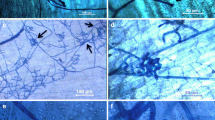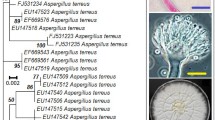Summary
Bacterial entry into potato tubers through wounds and lenticels was affected by the environment, especially by the prevailing relative humidity. Light and electron microscope examination of tubers inoculated withErwinia carotovora var.atroseptica under various environmental conditions showed that resistance to invasion was apparently due to the laying down of a barrier of suberin in the intercellular spaces and in two bands within the cell wall. The suberin barrier, if complete, prevents invasion; if, however, the barrier is incomplete, pectolysis spreads through the gaps and in such cases the suberin may be by-passed by the bacteria. Even in the absence of a complete suberin barrier, the periderm offers considerable resistance to bacterial invasion, due to the paucity of pectin and lack of intercellular spaces. In all cases the pathogen is wholly intercellular.
Zusammenfassung
Der Eintritt der Bakterien in die Kartoffelknollen durch Wunden und Lentizellen wurde durch die Umwelt beeinflusst. Die TTC (Triphenyltetrazoliumchlorid)-Reaktion der inokulierten Lentizellen zeigten, dass eine Infektion nur bei einer relativen Feuchtigkeit von mehr als 80% (Tabelle 1) vorkommt. Die Anfälligkeit frischer Wunden scheint eher durch die Entwicklung von Suberin als von Wundperiderm (Tabelle 2) begrenzt zu werden. Sowohl Verkorkung als auch Peridermbildung erfolgten bei hohen Temperaturen und/ oder relativer Feuchtigkeit schneller als bei niedriger (Tabelle 3). Bei in Inokulum eingelegten Knollen war die Eindringungsgeschwindigkeit unter Lentizellen konstant: diejenige unter Wunden war gleich, ausgenommen in den Anfangsstadien, als sie langsamer war (Abb. 3).
Untersuchunge im Licht- und Elektronenmikroskop von Knollen, die unter verschiedenen Umweltsbedingungen mitErwinia carotovora var.atroseptica inokuliert wurden, zeigten, dass die Resistenz gegen das Eindringen offenbar auf die Bildung einer Korkbarriere in den interzellularen Räumen und in zwei Bändern innerhalb der Zellwand (Abb. 1, 2, 4) zurückzuführen ist. Die Suberinschicht, wenn sie vollständig ist, verhindert das Eindringen; wenn die Barriere jedoch unvollständig ist, können beim Abbau von Pektin die Bakterien die Korkschicht umgeben (Abb. 5C, D). In befallenen Geweben sind die Bakterien völlig interzellulär (Abb. 5A, B). Selbst beim Fehlen einer vollständigen Barriere aus Suberin bietet das Periderm dank der geringen Menge Pektin und dem Fehlen interzellularer Räume (Abb, 4D, E, 1B) den eindringenden Bakterien beträchtlichen Widerstand. Der Hoepner-Vor-satz-Test zeigt an, dass sowohl in hoch empfindlichen, wuchernden Lentizellen als auch in resistenten Gewebe, wie z.B. Periderm, genügend Polyphenole vorhanden sind; sie sind stets intrazellulär, weshalb es wahrscheinlich ist, dass diese Substanzen nicht als eine direkte Schranke gegenErwinia wirken.
Résumé
La pénétration bactérienne dans les tubercules de pomme de terre par les blessures et les lenticelles dépendent de l'environnement. La réaction de lenticelles inoculées au TTC (triphenyl tetrazolium chlorure) montre que l'infection apparaît seulement à des humidités relatives supérieures à 80% (Tableau 1). La susceptibilité des blessures fraîches apparaît limitée par le développement de suber plutôt que par celui du périderme de blessure (Tableau 2). La tubérisation et la formation du périderme sont toutes deux plus rapides à haute température et/ou à humidité relative élevée plutôt que basse (Tableau 3). Chez les tubercules immergés dans l'inoculum, la vitesse de pénétration directement sous les lenticelles est constante; la pénétration directement sous les blessures est similaire sauf dans les stades initiaux où elle est plus lente (Fig. 3).
L'examen à la lumière et au microscope électronique de tubercules inoculés avecErwinia carotovora var.atroseptica sous diverses conditions de milieu montre que la résistance à l'invasion est due apparemment à la formation sousjacente d'une barrière de suber dans les espaces intercellulaires et dans deux bandes à l'intérieur de la paroi cellulaire (Fig. 1, 2, 4). La barrière de suber, si elle est complète, prévient l'invasion; si cependant la barrière est incomplète, la pectolyse s'étend au travers des lacunes et dès lors le suber peut être contourné par les bactéries (Fig. 5C, D). Dans les tissus envahis, les bactéries sont entièrement intercellulaires (Fig. 5A, B). De même lorsqu'une barrière complète de suber est absente, le périderme offre une résistance considérable à l'invasion bactérienne, en raison de la faible quantité de pectine et du manque d'espaces intercellulaires (Fig. 4D, E, 1B). Le test Hoepner-Vorsatz indique que les polyphénols sont abondants dans les lenticelles proliférantes hautement susceptibles aussi bien que dans les tissus résistants tel qu'un périderme, et sont toujours intracellulaires; par conséquent, il apparaît vraisemblable que ces substances ne constituent pas un rempart direct contreErwinia.
Similar content being viewed by others
References
Albersheim, P., Muhletaler, K. & Frey-Wyssling, A., 1960. Stained pectin as seen in the electron microscope.J. biophys. biochem. Cytol. 8: 501–516.
Artschwager, E. F., 1927. Wound periderm formation in the potato as affected by temperature and humidity.J. agric. Res. 35: 995–1000.
Bétencourt, A. & Prunier, J. P., 1965. A propos de la pourriture sèche lenticellaire des tubercules de pommes de terre provoquée parErwinia carotovora (Jones) Holland.Eur. Potato J. 8: 230–242.
Harper, P. C., Boyd, A. E. W. & Graham, D. C., 1963. Growth cracking and bacterial soft rot in potato tubers.Pl. Path. 12: 139–142.
Jones, D. Rudd & Dowson, W. J., 1950. On the bacteria responsible for soft rot in stored potatoes, and the reaction of the tuber to invasion byBacterium carotovorum Lehman & Neumann.Ann. appl. Biol. 37: 563–569.
Lovrekovich, L., Lovrekovich, H. & Stahmann, M. A., 1967. Inhibition of phenol oxidation byErwinia carotovora in potato tuber tissue and its significance in disease resistance.Phytopathology 57: 737–742.
Reeve, R. M., 1951. Histochemical tests for polyphenols in plant tissues.Stain Technol. 10: 395–396.
Smith, E. F., 1905. Bacteria in relation to plant diseases. Carnegie Institute, Washington, D.C.
Smith, M. A. & Ramsey, G. B., 1947. Bacterial lenticel infection of early potatoes.Phytopathology 37: 225–242.
Steedman, H. F., 1960. Section cutting in microscopy. Blackwell, Oxford.
Tulett, A. J., Bagshaw, V. & Yeoman, M. M., 1969. Arrangement and structure of plastids in dormant and cultured tissue from artichoke tubers.Ann. Bot. N.S. 33: 217–226.
Wood, R. K. S., 1967. Physiological plant pathology. Blackwell, Oxford.
Author information
Authors and Affiliations
Rights and permissions
About this article
Cite this article
Fox, R.T.V., Manners, J.G. & Myers, A. Ultrastructure of entry and spread ofErwinia carotovora var.atroseptica into potato tubers . Potato Res 14, 61–73 (1971). https://doi.org/10.1007/BF02355930
Accepted:
Issue Date:
DOI: https://doi.org/10.1007/BF02355930




